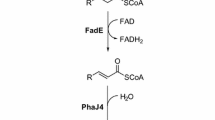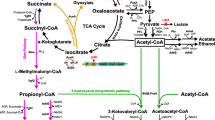Abstract
4-Hydroxyvaleric acid (4-HV) holds promise as a sustainable monomer for biodegradable polyesters and liquid transportation fuels. This study achieved high-level 4-HV production from levulinic acid using an antibiotic-free, substrate-inducible system in Escherichia coli. Enzymes involved in the conversion of levulinic acid to 4-HV were expressed with a bicistronic design of ribosome binding sites. The engineered strain demonstrated a 28% higher productivity compared to its counterpart, reaching a significant concentration of 107 g/L 4-HV with a production rate of 4.5 g/L/h and a molar conversion of 95% from levulinic acid in fed-batch cultivation. Recombinant cells from the initial cultivation were reused for a second round of biotransformation, demonstrating 73% efficiency of fresh cells. The study identified specific factors contributing to decreased system efficiency, including medium conditions, increased ionic strength, and high product concentration. Overall, the reported system and our findings hold significant potential for cost-effective microbial production of 4-HV at scale from levulinic acid.




Similar content being viewed by others
Data availability
The study’s original contributions and findings have been comprehensively documented within the article itself and the accompanying Supplementary Material. Should any further clarification or additional inquiries arise, readers are encouraged to direct them to the corresponding author, whose contact information is provided.
References
Stoklosa RJ, García-Negrón V, Latona RJ, Toht M. Limiting acetoin generation during 2,3-butanediol fermentation with Paenibacillus polymyxa using lignocellulosic hydrolysates. Bioresour Technol. 2024;393:130053. https://doi.org/10.1016/j.biortech.2023.130053.
Zhang Y, Yu J, Wu Y, Li M, Zhao Y, Zhu H, et al. Efficient production of chemicals from microorganism by metabolic engineering and synthetic biology. Chin J Chem Eng. 2021;30:14–28. https://doi.org/10.1016/j.cjche.2020.12.014.
Sathesh-Prabu C, Lee SK. Engineering the lva operon and optimization of culture conditions for enhanced production of 4-hydroxyvalerate from levulinic acid in Pseudomonas putida KT2440. J Agric Food Chem. 2019;67:2540–6. https://doi.org/10.1021/acs.jafc.8b06884.
Cho JS, Kim GB, Eun H, Moon CW, Lee SY. Designing microbial cell factories for the production of chemicals. JACS Au. 2022;2:1781–99. https://doi.org/10.1021/jacsau.2c00344.
Gorenflo V, Schmack G, Vogel R, Steinbüchel A. Development of a process for the biotechnological large-scale production of 4-hydroxyvalerate-containing polyesters and characterization of their physical and mechanical properties. Biomacromol. 2001;2:45–57. https://doi.org/10.1021/bm0000992.
Yu J. Biosynthesis of polyhydroxyalkanoates from 4-ketovaleric acid in bacterial cells. In: Cheng HN, Gross RA, editors. Green polymer chemistry: biocatalysis and biomaterials. Washington: American Chemical Society; 2010. p. 161–73. https://doi.org/10.1021/bk-2010-1043.ch012.
Bond JQ, Alonso DM, Wang D, West RM, Dumesic JA. Integrated catalytic conversion of gamma-valerolactone to liquid alkenes for transportation fuels. Science. 2010;327:1110–4. https://doi.org/10.1126/science.1184362.
Martin CH, Prather KLJ. High-titer production of monomeric hydroxyvalerates from levulinic acid in Pseudomonas putida. J Biotechnol. 2009;139:61–7. https://doi.org/10.1016/j.jbiotec.2008.09.002.
Yeon YJ, Park HY, Yoo YJ. Enzymatic reduction of levulinic acid by engineering the substrate specificity of 3-hydroxybutyrate dehydrogenase. Bioresour Technol. 2013;134:377–80. https://doi.org/10.1016/j.biortech.2013.01.078.
Moon M, Yeon YJ, Park HJ, Park J, Park GW, Kim GH, et al. Chemoenzymatic valorization of agricultural wastes into 4-hydroxyvaleric acid via levulinic acid. Bioresour Technol. 2021;337:125479. https://doi.org/10.1016/j.biortech.2021.125479.
Kim D, Sathesh-Prabu C, JooYeon Y, Lee SK. High-level production of 4-hydroxyvalerate from levulinic acid via whole-cell biotransformation decoupled from cell metabolism. J Agric Food Chem. 2019;67:10678–84. https://doi.org/10.1021/acs.jafc.9b04304.
Werpy T, Petersen G. Top value added chemicals from biomass: volume I—results of screening for potential candidates from sugars and synthesis gas. (No. DOE/GO-102004-1992). Golden: National Renewable Energy Lab (NREL); 2004.
Rand JM, Pisithkul T, Clark RL, Thiede JM, Mehrer CR, Agnew DE, et al. A metabolic pathway for catabolizing levulinic acid in bacteria. Nat Microbiol. 2017;2:1624–34. https://doi.org/10.1038/s41564-017-0028-z.
Sathesh-Prabu C, Tiwari R, Lee SK. Substrate-inducible and antibiotic-free high-level 4-hydroxyvaleric acid production in engineered Escherichia coli. Front Bioeng Biotechnol. 2022;10:960907. https://doi.org/10.3389/fbioe.2022.960907.
Mutalik VK, Guimaraes JC, Cambray G, Lam C, Christoffersen MJ, Mai Q-A, et al. Precise and reliable gene expression via standard transcription and translation initiation elements. Nat Methods. 2013;10:354–60. https://doi.org/10.1038/nmeth.2404.
Seo SW, Yang J, Min BE, Jang S, Lim JH, Lim HG, et al. Synthetic biology: tools to design microbes for the production of chemicals and fuels. Biotechnol Adv. 2013;31:811–7. https://doi.org/10.1016/j.biotechadv.2013.03.012.
Seo SW, Yang J-S, Kim I, Yang J, Min BE, Kim S, et al. Predictive design of mRNA translation initiation region to control prokaryotic translation efficiency. Metab Eng. 2013;15:67–74. https://doi.org/10.1016/j.ymben.2012.10.006.
Zhou L, Zuo Z-R, Chen X-Z, Niu D-D, Tian K-M, Prior BA, et al. Evaluation of genetic manipulation strategies on d-lactate production by Escherichia coli. Curr Microbiol. 2011;62:981–9. https://doi.org/10.1007/s00284-010-9817-9.
Sathesh-Prabu C, Tiwari R, Kim D, Lee SK. Inducible and tunable gene expression systems for Pseudomonas putida KT2440. Sci Rep. 2021;11:18079. https://doi.org/10.1038/s41598-021-97550-7.
Chen F, Cocaign-Bousquet M, Girbal L, Nouaille S. 5′UTR sequences influence protein levels in Escherichia coli by regulating translation initiation and mRNA stability. Front Microbiol. 2022;13:1088941. https://doi.org/10.3389/fmicb.2022.1088941.
Dvir S, Velten L, Sharon E, Zeevi D, Carey LB, Weinberger A, et al. Deciphering the rules by which 5′-UTR sequences affect protein expression in yeast. Proc Natl Acad Sci USA. 2013;110:E2792–801. https://doi.org/10.1073/pnas.1222534110.
Komarova AV, Tchufistova LS, Dreyfus M, Boni IV. AU-rich sequences within 5′ untranslated leaders enhance translation and stabilize mRNA in Escherichia coli. J Bacteriol. 2005;187:1344–9. https://doi.org/10.1128/jb.187.4.1344-1349.2005.
Habe H, Sato Y, Kirimura K. Microbial and enzymatic conversion of levulinic acid, an alternative building block to fermentable sugars from cellulosic biomass. Appl Microbiol Biotechnol. 2020;104:7767–75. https://doi.org/10.1007/s00253-020-10813-7.
Bozell J, Moens L, Elliott D, Wang Y, Neuenscwander G, Fitzpatrick S, et al. Production of levulinic acid and use as a platform chemical for derived products. Resour Conserv Recycl. 2000;28:227–39. https://doi.org/10.1016/S0921-3449(99)00047-6.
Rackemann DW, Doherty WOS. The conversion of lignocellulosics to levulinic acid. Biofuels Bioprod Biorefin. 2011;5:198–214. https://doi.org/10.1002/bbb.267.
Cha D, Ha HS, Lee SK. Metabolic engineering of Pseudomonas putida for the production of various types of short-chain-length polyhydroxyalkanoates from levulinic acid. Bioresour Technol. 2020;309:123332. https://doi.org/10.1016/j.biortech.2020.123332.
Hayes GC, Becer CR. Levulinic acid: a sustainable platform chemical for novel polymer architectures. Polym Chem. 2020;11:4068–77. https://doi.org/10.1039/D0PY00705F.
Pileidis FD, Titirici M-M. Levulinic acid biorefineries: new challenges for efficient utilization of biomass. Chemsuschem. 2016;9:562–82. https://doi.org/10.1002/cssc.201501405.
Mital S, Christie G, Dikicioglu D. Recombinant expression of insoluble enzymes in Escherichia coli: a systematic review of experimental design and its manufacturing implications. Microb Cell Factories. 2021;20:1–20. https://doi.org/10.1186/s12934-021-01698-w.
Xu P, Gu Q, Wang W, Wong L, Bower AGW, Collins CH, et al. Modular optimization of multi-gene pathways for fatty acids production in E. coli. Nat Commun. 2013;4:1409. https://doi.org/10.1038/ncomms2425.
Mohedano MT, Konzock O, Chen Y. Strategies to increase tolerance and robustness of industrial microorganisms. Synth Syst Biotechnol. 2022;7:533–40. https://doi.org/10.1016/j.synbio.2021.12.009.
Konzock O, Zaghen S, Norbeck J. Tolerance of Yarrowia lipolytica to inhibitors commonly found in lignocellulosic hydrolysates. BMC Microbiol. 2021;21:1–10. https://doi.org/10.1186/s12866-021-02126-0.
Park C, Raines RT. Quantitative analysis of the effect of salt concentration on enzymatic catalysis. J Am Chem Soc. 2001;123:11472–9. https://doi.org/10.1021/ja0164834.
Weimberg R. Effect of sodium chloride on the activity of a soluble malate dehydrogenase from pea seeds. J Biol Chem. 1967;242:3000–6. https://doi.org/10.1016/S0021-9258(18)99604-3.
Acknowledgements
We would like to acknowledge the financial support from the Basic Science Research Program, funded by the Ministry of Science, ICT and Future Planning (MSIT) through the National Research Foundation of Korea (NRF) (Grant No. NRF RS-2023-00208026). We are also grateful to the Circle Foundation for their support through the 2020 Innovative Science Project.
Funding
1. National Research Foundation of Korea (NRF) (Grant No. NRF RS-2023-00208026). 2. Innovative science project in 2020 of the Circle Foundation.
Author information
Authors and Affiliations
Contributions
C.S-P. conceived and designed the experiments, conducted all procedures, acquired and processed data, and drafted the initial manuscript. R.T. contributed to data processing and provided review. S.K.L. conceptualized and designed the study, validated the data, and critically revised the manuscript. All authors thoroughly reviewed and approved the manuscript's content.
Corresponding author
Ethics declarations
Conflict of interest
Not applicable.
Consent for publication
Not applicable.
Ethics approval and consent to participate
Not applicable.
Supplementary Information
Below is the link to the electronic supplementary material.
Rights and permissions
Springer Nature or its licensor (e.g. a society or other partner) holds exclusive rights to this article under a publishing agreement with the author(s) or other rightsholder(s); author self-archiving of the accepted manuscript version of this article is solely governed by the terms of such publishing agreement and applicable law.
About this article
Cite this article
Sathesh-Prabu, C., Tiwari, R. & Lee, S.K. Enhancing translation efficiency and exploring constraints in high-level 4-hydroxyvaleric acid production from levulinic acid in Escherichia coli. Syst Microbiol and Biomanuf (2024). https://doi.org/10.1007/s43393-024-00258-8
Received:
Revised:
Accepted:
Published:
DOI: https://doi.org/10.1007/s43393-024-00258-8




